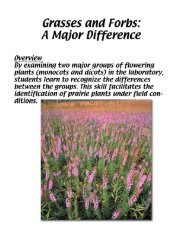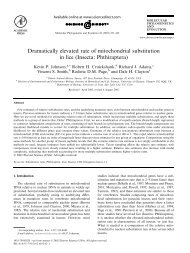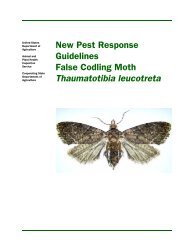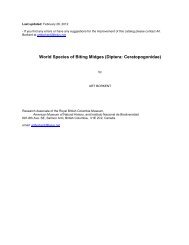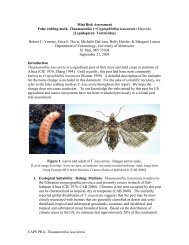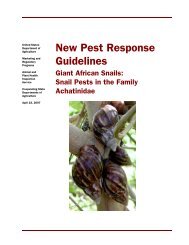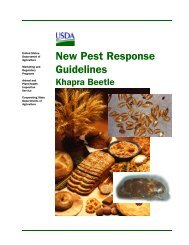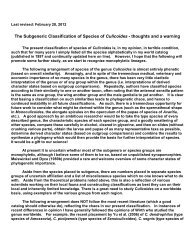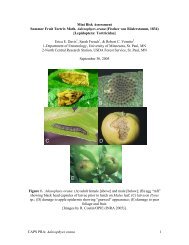Aquatic Invertebrates in Still and Flowing Waters
Aquatic Invertebrates in Still and Flowing Waters
Aquatic Invertebrates in Still and Flowing Waters
You also want an ePaper? Increase the reach of your titles
YUMPU automatically turns print PDFs into web optimized ePapers that Google loves.
Podzi ↩ekowanieAutorka pracy pragnie serdecznie podziekować ↩Panu Docentowi dr. hab. JanowiB̷l eckiemu ↩z Centrum Badań Kosmicznych PAN za przyjecie ↩do zespo̷lu opracowujacego↩dane misji DEMETER w ramach grantu 4T12E01628, opieke ↩i cenne uwagi w czasie pracynad materia̷lami eksperymentalnymi.Serdecznie dziekuj ↩e ↩Panu Profesorowi dr. hab. Markowi Gradowi z InstytutuGeofizyki Uniwersytetu Warszawskiego za życzliwość, pomoc i zaangażowanie w czasieopracowania wyników i redagowania tekstu n<strong>in</strong>iejszej pracy.Za udostepnienie ↩danych misji DEMETER i umożliwienie pracy nad nimi w Orleanie wInstytucie LPCE/CNRS (Laboratoire de Physique et Chimie de l’Environnement/CentreNational de Recherche Scientifique) dziekuj ↩e ↩Panu Profesorowi Michelowi Parrotoraz ca̷lej grupie badawczej.
Student Page 3: F<strong>in</strong>d<strong>in</strong>g FoodA basic process <strong>in</strong> aquatic ecology, as <strong>in</strong> all ecology, is energy flow—the movement of chemicalenergy with<strong>in</strong> a food cha<strong>in</strong>. A simple aquatic food cha<strong>in</strong> might go someth<strong>in</strong>g like this. A smallcrustacean feeds on algae (an herbivore) <strong>and</strong> is <strong>in</strong> turn eaten by a small fish which is then eaten by apredaceous beetle larva. When several of these simple food cha<strong>in</strong>s <strong>in</strong>teract together with detritivores(decomposers) <strong>and</strong> omnivores (organisms that eat animal <strong>and</strong> vegetable matter), they form a morecomplex structure that we call a. food web.The aquatic environment, like the terrestrial environment, supports herbivores, predators, omnivores,<strong>and</strong> scavengers. Herbivores graze on aquatic algae, mosses, <strong>and</strong> other aquatic plants. Predators chasedown their prey or wait <strong>in</strong> ambush for prey to pass by as they hide, camouflaged <strong>in</strong> plants or underrocks. Predators often have large, sharp mouthparts or grasp<strong>in</strong>g claws. Omnivores eat just aboutanyth<strong>in</strong>g, plant or animal. Scavengers (detritivores or decomposers) feed on dead <strong>and</strong> decay<strong>in</strong>gplants <strong>and</strong> animals. Some <strong>in</strong>vertebrates (filter feeders) filter f<strong>in</strong>e particles of food from the waterthrough netlike structures or by pump<strong>in</strong>g water through their bodies.When scientists study the structure <strong>and</strong> function<strong>in</strong>g of food webs, they use a specialized vocabularyto describe the relationships among organisms. A term often used <strong>in</strong> the study of food webs <strong>and</strong>energy flow is trophic, a word that comes from a Greek root mean<strong>in</strong>g to nourish. Trophic structure,then, is the nutritional <strong>in</strong>terrelationships among organisms <strong>in</strong> a particular food cha<strong>in</strong> or web. In thiscontext, the word nutritional is virtually synon-omous with the word energy.Questions:1. F<strong>in</strong>d three of each of the follow<strong>in</strong>g aquatic <strong>in</strong>vertebrates on the poster: predators, herbivores, <strong>and</strong>scavengers or filter feeders. Some <strong>in</strong>vertebrates fall <strong>in</strong>to more than one category.2. Choose ten organisms from the poster that represent several methods of obta<strong>in</strong><strong>in</strong>g food. As aclass, develop a food web (who eats whom) on the chalkboard. As shown <strong>in</strong> the food web below,arrows move from the organism be<strong>in</strong>g devoured to the one do<strong>in</strong>g the devour<strong>in</strong>g.
Student page 5: Locomotion (liv<strong>in</strong>g <strong>in</strong> <strong>and</strong> mov<strong>in</strong>g around the environment)<strong>Aquatic</strong> <strong>in</strong>vertebrates have many adaptations that allow them to move about their environment—they may swim, burrow, or climb about on rocks or plants. Swimm<strong>in</strong>g <strong>in</strong>vertebrates may have legsmodified to function as paddles. Their legs may have clusters (patches) of hairs that act very muchlike feathers on the w<strong>in</strong>g of a bird <strong>and</strong> allow the aquatic <strong>in</strong>vertebrate to "fly" under water.Some <strong>in</strong>vertebrates crawl about on the substrate (bottom surfaces) of the pond or stream; otherscl<strong>in</strong>g to plants <strong>and</strong> logs. These <strong>in</strong>vertebrates may have claws that help them cl<strong>in</strong>g to various surfaces.Animals that crawl on the substrate of a swiftly flow<strong>in</strong>g stream must be able to cl<strong>in</strong>g tightly or bewashed downstream. Many have flattened bodies.Leeches, a type of worm, cl<strong>in</strong>g to the substrate with a "suction cup" appendage. Snails, limpets (atype of snail with an uncoiled shell), <strong>and</strong> flatworms adhere to the substrate by cl<strong>in</strong>g<strong>in</strong>g with the flatundersides of their bodies.Many aquatic <strong>in</strong>vertebrates burrow <strong>in</strong> the substrate of a stream or pond. <strong>Aquatic</strong> earth wormspush their way through the soil with muscular contractions of their bodies. Mussels pull their shellsalong <strong>and</strong> through the bottom material with a muscular foot. Some <strong>in</strong>vertebrates, such asburrow<strong>in</strong>g mayflies, have legs that are spadelike. Burrow<strong>in</strong>g <strong>in</strong>vertebrates, such as sludge worms orburrow<strong>in</strong>g mayflies, <strong>and</strong> some midge <strong>and</strong> caddisfly larvae, may construct tubelike homes on thebottom.The water's surface is a unique habitat that many aquatic <strong>in</strong>vertebrates are able to exploit. Thesurface of the water behaves as if there were a film across it. This filmlike property of water is calledsurface tension. Very lightweight animals are able to walk on the surface of the water. In fact, somesmall <strong>in</strong>vertebrates may actually have difficulty break<strong>in</strong>g through the surface tension.Questions;1. F<strong>in</strong>d three <strong>in</strong>vertebrates that swim through the water <strong>and</strong> describe one special adaptation that helpseach to swim.2. F<strong>in</strong>d five <strong>in</strong>vertebrates that crawl on or cl<strong>in</strong>g to the substrate (rocks, logs, plants) us<strong>in</strong>g legsequipped with claws.3. F<strong>in</strong>d a leech, a limpet, two snails, <strong>and</strong> a flatworm on the poster.4. F<strong>in</strong>d examples of aquatic earthworms, mussels, burrow<strong>in</strong>g mayflies <strong>and</strong> sludge worms on theposter. Compare their adaptations for burrow<strong>in</strong>g.
Student page 6: Life Cycles <strong>and</strong> Reproduction (non-<strong>in</strong>sects)Some aquatic <strong>in</strong>vertebrates, such as aquatic worms, mollusks, <strong>and</strong> most of the crustaceans, live theirentire lives <strong>in</strong> water. Crayfish can leave the water for short periods of time, but most species spendmost of their lives <strong>in</strong> the water. Those that dig burrows with chimneylike entrance holes live near thewater. They also return to the water to reproduce. Crayfish mate dur<strong>in</strong>g the late w<strong>in</strong>ter or earlyspr<strong>in</strong>g, <strong>and</strong> later <strong>in</strong> the spr<strong>in</strong>g the female lays her eggs. She carries them <strong>in</strong> a mass under her tail. Theegg mass looks very much like a raspberry, <strong>and</strong> a female carry<strong>in</strong>g eggs is said to be "<strong>in</strong> berry." Whenthe young crayfish hatch, they ride along under their mother's tail for a week or more. After a fewdays, the fully formed but m<strong>in</strong>iature crayfish are on their own. Very young crayfish can often befound hid<strong>in</strong>g <strong>and</strong> feed<strong>in</strong>g <strong>in</strong> masses of algae or among plants <strong>in</strong> shallow water.Water fleas are t<strong>in</strong>y crustaceans. Most of the population are females that reproduce parthenogenically,that is, the eggs develop without fertilization by a male. Water Fleas are born alive.Occasionally, males are produced <strong>and</strong> mate with some of the females. Eggs produced <strong>in</strong> this mannerare cysts capable of ly<strong>in</strong>g dormant for years before hatch<strong>in</strong>g.<strong>Aquatic</strong> snails, such as ram's hom snails <strong>and</strong> limpets, are hermaphrodites—which means thateach organism has both male <strong>and</strong> female reproductive organs. Any two snails can mate <strong>and</strong> fertilizeeach other's eggs. Male <strong>and</strong> female river snails, however, are separately sexed. Most aquatic snails <strong>in</strong>Ill<strong>in</strong>ois lay gelat<strong>in</strong>ous masses of eggs on plants <strong>and</strong> substrate. A few species of snails give birth tolive, fully formed young.Even though f<strong>in</strong>gernail clams look like m<strong>in</strong>iature versions of mussels, they reproduce verydifferently. F<strong>in</strong>gernail clams are hermaphrodites. Sperm is released <strong>in</strong>to the water <strong>and</strong> picked up bythe gills, where the eggs are fertilized. The eggs then develop <strong>in</strong> a brood pouch. F<strong>in</strong>gernail clamslater give birth to fully formed baby f<strong>in</strong>gernail clams, t<strong>in</strong>y versions of their parents. Most freshwatermussels are either male or female. The males release sperm <strong>in</strong>to the water. Some of these sperm arepicked up by the females <strong>and</strong> their eggs are fertilized <strong>in</strong> the gills. Early development takes place <strong>in</strong>the gills, but later, thous<strong>and</strong>s of t<strong>in</strong>y larvae are released <strong>and</strong> attach themselves to the gills of fish.Until they are ready to transform <strong>in</strong>to adults, these larvae, or glochidia, live as parasites on the gillsof fish. Some species of mussels release their glochidia <strong>in</strong>to the gills of only one species of fish.Questions:1. F<strong>in</strong>d a crayfish on the poster; f<strong>in</strong>d the water flea.2. F<strong>in</strong>d two snails, a mussel, <strong>and</strong> a group of f<strong>in</strong>gernail clams on the poster.3. If a species of mussel can release its glochidia onto only one species of fish <strong>and</strong> that fishdisappears from the stream or pond, what happens to the-mussel population?
Student page 7: Life Cycles <strong>and</strong> Reproduction (<strong>in</strong>sects)<strong>Aquatic</strong> <strong>in</strong>sects are a very diverse group <strong>and</strong> demonstrate a wide variety of life cycles <strong>and</strong>reproductive strategies. Many aquatic <strong>in</strong>sects have immature stages that live <strong>in</strong> water but adult(reproductive) stages that live near water. Some <strong>in</strong>sects experience <strong>in</strong>complete metamorphosis <strong>in</strong>which the immature stage (nymph) lives <strong>in</strong> the water. It resembles the adult but lacks w<strong>in</strong>gs. Theolder nymphs develop "w<strong>in</strong>g pads," which are the develop<strong>in</strong>g w<strong>in</strong>gs. When they molt <strong>in</strong>toadulthood, they leave the water with their now functional w<strong>in</strong>gs. Dragonflies, damselflies, true bugs(giant water' bugs, water scorpions, water boatmen <strong>and</strong> water striders), stoneflies, <strong>and</strong> mayfliesdemonstrate this life cycle.The female giant water bug deposits her fertilized eggs, which may number over one hundred,onto the back of the male by secret<strong>in</strong>g a waterproof glue. The male then carries them with him untilthey hatch, usually <strong>in</strong> about ten days.Because dragonflies <strong>and</strong> damselflies are highly predaceous, gett<strong>in</strong>g the sexes together for mat<strong>in</strong>gis tricky! Males have developed a unique way to solve this problem. A male takes sperm from the tipof his abdomen <strong>and</strong> places it <strong>in</strong> a receptacle near the base of his abdomen. He then seeks out afemale, grabs her beh<strong>in</strong>d the head with claspers on the end of his abdomen. She then reaches aroundwith her abdomen <strong>and</strong> couples with the sperm receptacle. After she has been <strong>in</strong>sem<strong>in</strong>ated, both flyoff, still <strong>in</strong> t<strong>and</strong>em, <strong>and</strong> she lays her eggs <strong>in</strong> the water. Often the male does not release the femaleuntil she has completed lay<strong>in</strong>g her eggs, thus prevent<strong>in</strong>g other males from fertiliz<strong>in</strong>g her eggs.Some aquatic <strong>in</strong>sects demonstrate complete metamorphosis <strong>in</strong> which the eggs hatch <strong>in</strong>to a larvalstage that is very different <strong>in</strong> appearance from the adult. For example, flies, which <strong>in</strong>cludemosquitoes <strong>and</strong> midges, have soft-bodied larvae without segmented legs. When the larva is ready totransform <strong>in</strong>to an adult, it must enter a pupal stage for the change to adult to take place. The larvae ofbeetles, caddisflies, <strong>and</strong> dobsonflies have segmented legs <strong>and</strong> may have a hardened, chit<strong>in</strong>ized body.Questions:1. Locate on the poster both nymph <strong>and</strong> adult damselfies, stoneflies, mayflies, <strong>and</strong> dragonflies.2. Locate a pair of damselflies <strong>in</strong> the process of lay<strong>in</strong>g eggs.3. Look for the male giant water bug with eggs attached. How does this adaptation aid <strong>in</strong> the survivalof its young?4. Locate larvae of phantom midges <strong>and</strong> other midges <strong>and</strong> a complete life cycle (egg, larva, pupa,<strong>and</strong> adult) of the mosquito.5. F<strong>in</strong>d three adult beetles, three larval beetles <strong>and</strong> one larva of the dobsonfly <strong>and</strong> caddisfly.
Student page 8: Gett<strong>in</strong>g around (dispersal)Adults of many aquatic <strong>in</strong>sects can fly; they simply crawl out of the water <strong>and</strong> fly to a new pond orstream. Crayfish are capable of leav<strong>in</strong>g a stream <strong>and</strong> trekk<strong>in</strong>g across l<strong>and</strong>. In some species of<strong>in</strong>vertebrates, the immature stages live <strong>in</strong> the water <strong>and</strong> the adults are terrestrial. Many <strong>in</strong>vertebratesmust rely on occasional flood<strong>in</strong>g to relocate to a new area. Sometimes the sticky eggs or the t<strong>in</strong>yyoung of snails hitch a ride on the feet of ducks <strong>and</strong> other water birds.To move about with<strong>in</strong> a pond or stream, <strong>in</strong>vertebrates crawl or swim. One means of dispersalcommonly used by <strong>in</strong>vertebrates <strong>in</strong> a stream is to allow the current to carry them downstream.Drift<strong>in</strong>g requires very little energy <strong>and</strong> quickly moves an <strong>in</strong>vertebrate to a new area.Other <strong>in</strong>sects have very specialized adaptations. Whirligig beetles swim on the surface film ofquiet waters. Each of its compound eyes is divided <strong>in</strong>to two parts. The lower part looks under thewater while the upper portion looks up <strong>in</strong>to the air. The larva of the phantom midge has bubbles ofair trapped <strong>in</strong>side its body so it rema<strong>in</strong>s buoyant <strong>and</strong> floats near the water surface. \ -Questions:1. F<strong>in</strong>d five <strong>in</strong>vertebrates that can move to a new pond or stream by fly<strong>in</strong>g at some stage of their lifecycles <strong>and</strong> five that cannot.2. Why might an aquatic <strong>in</strong>vertebrate disperse to a new location?3. Locate the whirligig beetle on the poster <strong>and</strong> note its divided eyes. Why does it need to look bothup <strong>and</strong> down?4. F<strong>in</strong>d the phantom midge larva on the poster <strong>and</strong> look for the trapped air bubbles.



